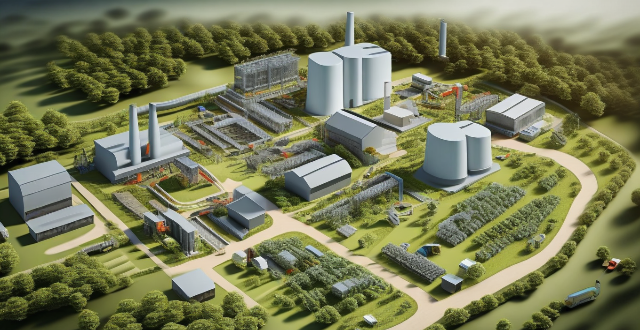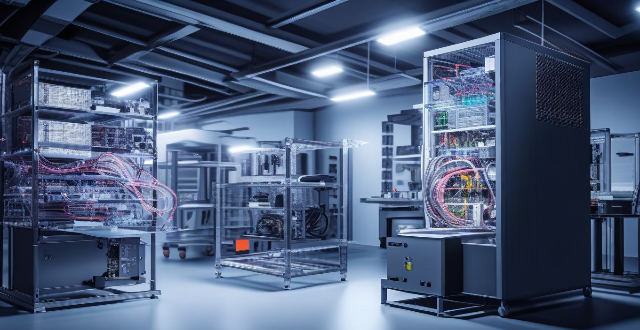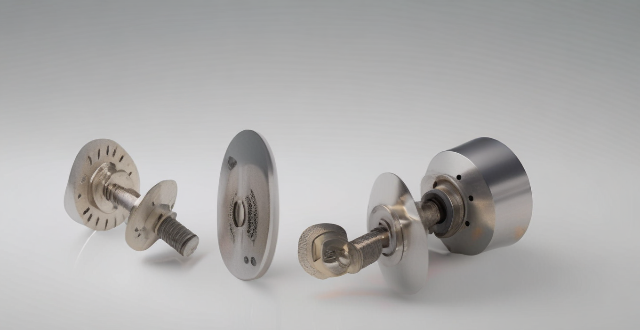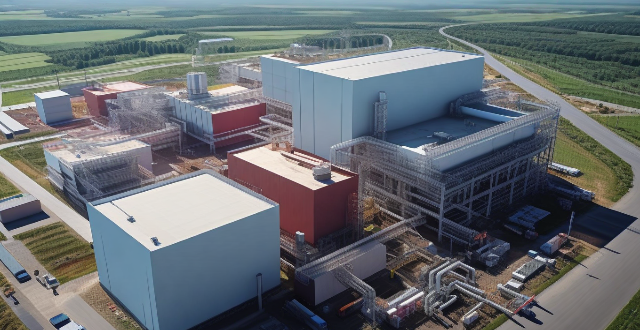End Manufacturing

Are there any environmental concerns associated with the production and disposal of DC brushed motors ?
The article discusses the environmental concerns associated with DC brushed motors, including high energy consumption, material extraction and processing, manufacturing processes, and end-of-life disposal. It suggests potential solutions such as improved efficiency, sustainable material sourcing and processing, eco-friendly manufacturing practices, and responsible end-of-life management to mitigate their impact on the environment.

How has the adoption of Industry 4.0 technologies influenced energy efficiency in manufacturing ?
Industry 4.0 technologies significantly impact energy efficiency in manufacturing by enabling precision and optimization, data-driven decision making, resource management, promoting sustainability, and enhancing employee engagement. These advancements contribute to a future where smart manufacturing and sustainability are intertwined.

What is the impact of smart manufacturing on industrial energy consumption ?
Smart manufacturing, or Industry 4.0, is transforming industrial operations through AI, IoT, and robotics to boost efficiency and sustainability. One major benefit is its impact on reducing energy consumption in industries. This article discusses how smart manufacturing can aid in decreasing energy usage: 1. **Optimization of Production Processes**: Real-time data analytics and predictive maintenance techniques lead to less energy waste and higher efficiency. Sensors monitor equipment performance to reduce downtime and energy consumption during repairs. 2. **Automation and Robotics**: Replacing manual labor with automated machines and robots results in higher precision and consistency while minimizing energy usage. Smart technologies also enable better resource allocation for reduced energy consumption. 3. **Energy Management Systems (EMS)**: EMS are crucial for monitoring and controlling energy consumption. They provide insights into energy usage patterns, allowing companies to identify areas where energy savings can be achieved. Implementing energy-saving measures based on EMS data can significantly cut energy consumption and costs. 4. **Renewable Energy Sources**: Smart manufacturing promotes the use of renewable energy sources like solar and wind power to reduce dependence on non-renewable sources like fossil fuels. This contributes to environmental sustainability by lowering greenhouse gas emissions. Integrating smart grids into industrial facilities further optimizes energy distribution and enhances efficiency. Overall, smart manufacturing significantly impacts industrial energy consumption by optimizing production processes, incorporating automation and robotics, implementing energy management systems, and promoting renewable energy sources. These advancements not only reduce energy waste but also contribute to environmental sustainability by lowering greenhouse gas emissions.

**What exactly is end-to-end encryption offered by iCloud ?
End-to-end encryption is a security measure that ensures data transmitted between two endpoints, such as a user's device and iCloud, can only be read by the intended recipient. This means that even if someone intercepts the data during transmission, they will not be able to access or modify it without the proper encryption keys. Key features of end-to-end encryption offered by iCloud include: 1. Data Privacy: End-to-end encryption ensures that your data remains private and secure while being transmitted over the internet. 2. Security: With end-to-end encryption, even Apple cannot access your data because they do not hold the encryption keys. Only you and the recipient of your data have access to the keys needed to decrypt the information. 3. Trustworthiness: By offering end-to-end encryption, iCloud demonstrates its commitment to protecting users' privacy and building trust with its customers. 4. Compliance with Regulations: End-to-end encryption also helps iCloud comply with various regulations related to data protection and privacy, such as the General Data Protection Regulation (GDPR) in Europe and the California Consumer Privacy Act (CCPA) in the United States. 5. User Control: End-to-end encryption gives users more control over their data by allowing them to choose when and how their information is shared. For example, users can decide whether to use end-to-end encryption for specific types of data or for all their data stored in iCloud. Overall, end-to-end encryption offered by iCloud provides several benefits, including enhanced data privacy, security, trustworthiness, compliance with regulations, and user control.

What are some drugstore makeup brands that rival high-end products ?
Drugstore makeup brands like CoverGirl, Maybelline, L'Oréal Paris, and Revlon offer quality products at a fraction of the cost of high-end makeup brands. These brands provide a wide range of products, including foundation, blush, eyeshadow, and mascara, that rival high-end products in terms of quality and affordability. By choosing these brands, you can save money while still enjoying high-quality makeup products.

How do I recognize a truly exceptional high-end dining experience ?
When it comes to identifying an exceptional high-end dining experience, there are several key factors that set these establishments apart from the rest. Here are some of the most important aspects to consider: 1. Ambiance and Atmosphere: The decor and design should be elegant, sophisticated, and inviting. Seating arrangements should be comfortable and spacious, allowing for privacy and intimacy. Attention to detail is crucial, including things like fresh flowers on the table, high-quality tableware, and attentive service. 2. Quality of Food and Drinks: The quality of ingredients used in dishes is crucial. Look for restaurants that source their ingredients locally and seasonally, and pay attention to how the food is prepared and presented. Creativity and innovation are also important, with chefs pushing the boundaries of culinary arts. A comprehensive wine list with a wide variety of options, including rare and exclusive wines, is another sign of a top-notch dining experience. 3. Service and Hospitality: The staff should be knowledgeable, professional, and friendly. They should be able to answer questions about the menu and provide recommendations based on your preferences. Anticipatory service is key, with the best restaurants anticipating their guests' needs before they even ask. Personalization is also important, with special requests for dietary restrictions or allergies accommodated, as well as recommendations based on individual tastes. 4. Extra Touches: If you're celebrating a special occasion, look for restaurants that offer extra touches like complimentary desserts or champagne toasts. Some high-end restaurants have unique features that set them apart from others, such as private dining rooms, outdoor terraces, or stunning views of the cityscape. Consistency is key when it comes to recognizing an exceptional high-end dining experience, with the food, service, and overall atmosphere consistently excellent every time you visit.

What type of customer service can I expect at a high-end resort ?
When you visit a high-end resort, you can expect to receive exceptional customer service. The staff at these establishments are trained to provide personalized attention and ensure that your stay is comfortable and enjoyable. Some of the services you can expect include personalized attention, complimentary amenities, concierge services, room service, housekeeping services, and security and safety measures. Overall, a high-end resort will go above and beyond to make sure that your needs are met and that you have an unforgettable experience.

In which industries are permanent magnet motors most commonly used ?
Permanent magnet motors are utilized across a wide range of industries due to their efficiency and reliability. Key sectors include the automotive industry, where they power electric and hybrid vehicles and are used in automated manufacturing. In aerospace and defense, PM motors are crucial for aircraft systems and military applications. Appliance manufacturing benefits from PM motors in household and commercial equipment. The medical sector employs them in imaging equipment and surgical tools. Manufacturing and process control use PM motors in CNC machinery and pumps/valves. Renewable energy sectors such as wind turbines and solar tracking systems also rely on these motors. Consumer electronics, including audio and visual equipment as well as toys and hobbyist products, make use of permanent magnet motors for various functions.

How has automation changed the manufacturing industry ?
Automation has significantly impacted the manufacturing industry by increasing productivity, reducing costs, enhancing safety, and providing flexibility. It has also led to improved data collection and analysis but has shifted labor force needs and raised environmental considerations.

How do safety regulations affect the manufacturing industry ?
Safety regulations are critical in manufacturing for worker safety, environmental protection, and product quality assurance but can increase costs and administrative burden while potentially slowing innovation.

What is the role of artificial intelligence in modern rocket technology ?
The article discusses the pivotal role of Artificial Intelligence (AI) in revolutionizing various aspects of modern rocket technology. It explores how AI is transforming design and manufacturing processes, including computational fluid dynamics simulations, machine learning-driven material science, and automated manufacturing. The text also delves into AI's contributions to launch and orbital insertion, such as predictive maintenance, trajectory optimization, and real-time decision making. Furthermore, it highlights AI applications in on-orbit operations like autonomous navigation, swarm intelligence, and fault detection and recovery. The article concludes by discussing future implications of AI in deep space exploration, reusable rocketry, and collaborative robotics, emphasizing its potential to make space missions safer, more efficient, and cost-effective.

What are the environmental impacts of electric cars ?
Electric cars, also known as EVs (Electric Vehicles), have become increasingly popular in recent years due to their potential to reduce greenhouse gas emissions and improve air quality. However, like any other technology, electric cars also have some environmental impacts that need to be considered. In this article, we will discuss the various environmental impacts of electric cars. One of the most significant environmental benefits of electric cars is their ability to reduce greenhouse gas emissions. Compared to traditional gasoline-powered vehicles, electric cars produce zero tailpipe emissions. This means that they do not release harmful pollutants such as carbon dioxide, nitrogen oxides, and particulate matter into the atmosphere. As a result, electric cars can help reduce air pollution and improve public health. The environmental impact of electric cars also depends on the source of energy used for charging them. If the electricity used to charge an electric car comes from renewable sources such as wind or solar power, then the overall environmental impact is positive. However, if the electricity comes from coal-fired power plants or other non-renewable sources, then the environmental benefits are reduced. It is essential to ensure that the electricity used for charging electric cars comes from clean and sustainable sources. The production of lithium-ion batteries used in electric cars has some environmental impacts. The mining and processing of raw materials required for battery production can lead to water pollution, soil contamination, and habitat destruction. Additionally, the disposal of spent batteries can pose challenges as they contain toxic chemicals that can harm the environment if not disposed of properly. Recycling programs and research into alternative battery technologies can help mitigate these impacts. The manufacturing process of electric cars also has some environmental impacts. The production of electric car components requires energy and resources, which can lead to greenhouse gas emissions and other forms of pollution. However, compared to traditional gasoline-powered vehicles, electric cars generally have a lower environmental impact during the manufacturing process due to their simpler design and fewer moving parts. To fully understand the environmental impacts of electric cars, it is essential to consider their entire lifecycle, including raw material extraction, manufacturing, use, and disposal. A comprehensive lifecycle analysis can help identify areas where improvements can be made to reduce the overall environmental impact of electric cars. This may include using more sustainable materials, improving energy efficiency during manufacturing, and developing better recycling programs for spent batteries. In conclusion, while electric cars offer significant environmental benefits over traditional gasoline-powered vehicles, they also have some environmental impacts that need to be considered. By addressing these issues through sustainable practices and continued research, we can maximize the positive environmental impacts of electric cars and work towards a cleaner, greener future.

When does Black Friday start and end ?
Black Friday is a shopping event that occurs on the day after Thanksgiving in the United States. It marks the beginning of the Christmas shopping season and is known for its significant discounts and promotions offered by retailers. The start date of Black Friday is the Friday immediately following Thanksgiving Day, while the end date is typically at midnight on the same day. However, many retailers extend their sales throughout the weekend, leading into Cyber Monday, creating a shopping period often referred to as "Black Friday Weekend." In recent years, some retailers have even started their Black Friday deals on Thanksgiving Day itself or earlier, blurring the traditional start and end dates even further.

Do Outlet Stores offer discounts on high-end luxury brands ?
Outlet stores are known for offering discounts on various products, but when it comes to high-end luxury brands, discounts are rare. Luxury brands maintain strict control over their pricing strategies to preserve their image and exclusivity. However, there are alternative ways for consumers to save money on luxury items without sacrificing quality and prestige.

Are Leonardo DiCaprio and Camila Morrone still dating ?
Leonardo DiCaprio and Camila Morrone's relationship status has been subject to speculation, with rumors suggesting they may have ended their romance. The couple first sparked dating rumors in 2017 and managed to keep their relationship relatively private since then. However, recent reports indicate that they might have called it quits due to conflicting schedules and lifestyle differences. While there has been no official confirmation from either party regarding the end of their relationship, multiple sources have reported that they have gone their separate ways.

**Is my data safe with iCloud's privacy features ?
iCloud, Apple's cloud storage service, offers several privacy and security features to protect user data. These include Private Relay for anonymous browsing, end-to-end encryption for secure transmission, two-factor authentication for account security, tracking prevention for apps and websites, data breach notifications, encrypted cloud storage, privacy reports, password security monitoring, child safety features, and regular security updates. While these features provide robust protection, users should still practice good digital hygiene to further safeguard their data.

Is it possible to create a truly sustainable "green" battery ?
Creating a truly sustainable "green" battery is an ambitious goal that aligns with the global effort to reduce environmental impact and transition towards renewable energy sources. However, achieving this objective presents significant challenges and requires innovations in materials, design, and production processes. Key considerations for sustainable batteries include eco-friendly raw materials sourcing, recyclability, energy-efficient manufacturing processes, waste management, high energy density, longevity, comprehensive recycling programs, and secondary uses. Challenges and trade-offs involve technological limitations such as research and development needs and potential performance trade-offs, economic implications like increased production costs and market adoption challenges, as well as legislative and regulatory frameworks needed to promote green batteries. In conclusion, creating a truly sustainable "green" battery is feasible but complex, involving multifaceted approaches across material selection, manufacturing processes, product performance, and end-of-life management.

Are there any luxury ski resorts with high-end spa facilities ?
Luxury ski resorts with high-end spa facilities offer a range of treatments including massages, facials, body treatments, and salon services. The Remede Spa at The Little Nell in Aspen, Colorado, the Four Seasons Spa in Jackson Hole, Wyoming, the Remède Spa at St. Regis Deer Valley in Park City, Utah, the Willow Stream Spa at Fairmont Banff Springs in Alberta, Canada, and the Bliss Spa at W Verbier in Switzerland are all examples of such resorts that cater to the needs of their guests. These resorts also feature relaxation lounges, steam rooms, saunas, and fitness centers to enhance the overall experience.

What are the best high-end restaurants in New York City ?
New York City is known for its diverse and vibrant food scene, with countless high-end restaurants offering exceptional dining experiences. Here are some of the best high-end restaurants in NYC: 1. Eleven Madison Park - a three-Michelin-starred restaurant located in the heart of Manhattan, offering a seasonal menu that showcases locally sourced ingredients and innovative dishes. 2. Le Bernardin - another three-Michelin-starred restaurant known for its exquisite seafood dishes, serving seafood simply prepared to let the natural flavors shine through. 3. Per Se - a Michelin three-starred restaurant located inside the iconic Time Warner Center, offering a nine-course tasting menu that changes daily based on seasonal ingredients. 4. Jean-Georges - a Michelin three-starred restaurant located in the Trump International Hotel & Tower, offering contemporary French cuisine with a focus on local and seasonal ingredients. 5. Masa - an upscale Japanese restaurant located in the Time Warner Center, offering a multi-course tasting menu featuring traditional Japanese dishes made with the finest ingredients. 6. Chef's Table at Brooklyn Fare - a Michelin three-starred restaurant located in Brooklyn, offering a unique dining experience where guests sit around an open kitchen and watch the chefs prepare their meals. 7. Gramercy Tavern - a Michelin two-starred restaurant located in the Flatiron District, offering contemporary American cuisine with a focus on seasonal ingredients. 8. Blue Hill at Stone Barns - a Michelin three-starred restaurant located in Pocantico Hills, offering a unique dining experience where guests can enjoy their meals while surrounded by beautiful gardens and farmland, featuring locally sourced ingredients and innovative dishes.

Which high-end eateries offer vegan options for fine dining ?
Veganism is a lifestyle choice that has gained immense popularity in recent years. It involves abstaining from the use of animal products, including meat, dairy, and eggs. This lifestyle choice has led to an increase in demand for vegan options in high-end restaurants. Here are some of the best fine dining restaurants that offer vegan options: 1. Crossroads - Los Angeles, California 2. Millennium - San Francisco, California 3. Acorn - Vancouver, Canada 4. Vedge - Philadelphia, Pennsylvania

How do clean production technologies help reduce waste and pollution ?
Clean production technologies are vital in reducing waste and pollution. They achieve this through energy efficiency, resource efficiency, improved waste management, pollution control, and a holistic approach to sustainability via life cycle assessment. By implementing these technologies, industries can operate in a more sustainable manner, minimizing their environmental impact.

Are there any celebrity-owned or frequented high-end restaurants I should try ?
If you're looking for a high-end dining experience with a celebrity touch, several restaurants owned by or frequented by celebrities are worth trying. Here are some of the top options: 1\. **Nobu Malibu**: Located in Malibu, California, and owned by Robert De Niro, Nobu Malibu offers stunning views of the Pacific Ocean and signature dishes like Black Cod with Miso and Yellowtail Sashimi with Jalapeño. 2\. **Giorgio Baldi**: Known for its romantic atmosphere and delicious Italian cuisine, Giorgio Baldi in Santa Monica, California, is formerly owned by George Clooney. Must-try dishes include the Lobster Ravioli and the Branzino al Salmoriglio. 3\. **The Polo Lounge**: The Polo Lounge at the Beverly Hills Hotel is a classic Hollywood haunt where you can enjoy traditional American fare while keeping an eye out for A-listers. Don't miss the signature McCarthy Salad and the Prime Rib. 4\. **Mr. Chow**: Mr. Chow is a legendary Chinese restaurant chain that has been a favorite among celebrities for decades. The menu features upscale Chinese cuisine, including Peking Duck and XO King Prawns. 5\. **TAO Downtown**: TAO Downtown is a vibrant nightlife destination that also serves upscale Asian fusion cuisine. The menu includes sushi, dim sum, and larger plates like Whole Lobster with Truffle Ginger Sauce. 6\. **Madeo**: Madeo is a chic Italian restaurant that attracts a celebrity crowd with its modern Italian cuisine and trendy atmosphere. Dishes like the Cacio e Pepe and the Branzino Al Forno are standouts on the menu. 7\. **Catch LA**: Catch LA is a seafood restaurant and rooftop bar that has become a celebrity magnet thanks to its delicious food and lively atmosphere. Must-try dishes include the Yellowtail Snapper Crudo and the Lobster Newburg. 8\. **Spago Beverly Hills**: Owned by celebrity chef Wolfgang Puck, Spago Beverly Hills is known for its innovative Californian cuisine. The menu features seasonal dishes like Roasted Chicken with Morel Mushrooms and Artichokes Barigoule. 9\. **Chiltern Firehouse**: Chiltern Firehouse is a members-only club that has become a favorite among celebrities like Emma Watson and Kate Moss. The menu features upscale British cuisine, including dishes like Beef Wellington and Fish and Chips. 10\. **The Ivy**: The Ivy in Los Angeles is a legendary spot for celebrity sightings and power lunches. The menu offers classic American fare like Crab Cakes and Grilled NY Steak.

How can circular economy policies be applied to different industries ?
The circular economy is a concept aimed at reducing waste and maximizing resource use across various industries. Here are key ways to apply circular economy policies in different sectors: 1. **Manufacturing**: Implement resource efficiency, remanufacturing, design for disassembly, and sustainable supply chain management. 2. **Agriculture**: Adopt crop rotation, composting, precision farming, and aquaponics systems. 3. **Energy**: Utilize renewable energy sources, improve energy efficiency, implement waste-to-energy solutions, and develop smart grids. 4. **Fashion**: Use sustainable materials, promote rental and secondhand markets, establish closed-loop production, and ensure transparency and traceability. 5. **Food and Beverage**: Reduce food waste, minimize packaging, upcycle byproducts, and conserve water. 6. **Construction**: Employ modular design, use green building materials, incorporate energy-efficient designs, and plan for deconstruction.

What are the costs associated with implementing satellite communication systems ?
The text discusses the costs involved in implementing satellite communication systems, including design and development, manufacturing and production, launch and deployment, operational, and decommissioning expenses. It emphasizes the need to consider these costs throughout the system's lifecycle to determine its feasibility and profitability.

Why is it important to recycle electronic waste ?
Recycling electronic waste is crucial for environmental sustainability, public health, and economic benefits. It conserves natural resources, reduces landfill space, prevents toxicity, creates jobs, saves costs, promotes green technology, reduces exposure to toxic substances, protects biodiversity, extends product lifespan, and raises awareness. Understanding the importance of e-waste recycling can lead to informed decisions that contribute to a circular economy and a healthier planet.

Is it possible to recycle the magnets used in permanent magnet motors at the end of their life cycle ?
Permanent magnet motors are widely used in various applications, including electric vehicles, wind turbines, and industrial machinery. However, these motors rely on strong permanent magnets to generate torque and convert electrical energy into mechanical energy. As with any technology, these magnets have a limited lifespan and will eventually need to be replaced or recycled. In this article, we will explore the feasibility of recycling permanent magnets used in motors at the end of their life cycle. One of the main challenges in recycling permanent magnets is that they often contain harmful materials such as neodymium (Nd), dysprosium (Dy), and boron (B). These elements are toxic and require special handling during the recycling process to prevent environmental contamination. Additionally, the extraction and refining processes for these elements can be energy-intensive and costly. Another challenge is the complexity of the recycling process itself. Permanent magnets are typically made up of multiple layers of different materials, including iron, copper, aluminum, and rare earth metals. Separating these materials requires specialized equipment and techniques, which can be expensive and time-consuming. Furthermore, the quality of recycled magnets may not be as high as that of newly manufactured magnets, potentially limiting their usefulness in certain applications. Despite the challenges mentioned above, recycling permanent magnets has several potential benefits. One significant advantage is the conservation of rare earth metals, which are essential components of many modern technologies but are also relatively scarce resources. By recovering these metals from discarded magnets, we can reduce our reliance on new mining operations and help ensure a more sustainable supply chain for critical technologies. Recycling permanent magnets can also lead to cost savings and improved energy efficiency. By reusing materials that would otherwise be discarded, we can reduce waste and lower production costs for new magnets. Additionally, since the recycling process itself requires less energy than extracting and refining raw materials from scratch, it can contribute to overall energy savings and reduced greenhouse gas emissions. There are several methods for recycling permanent magnets, including mechanical separation, chemical extraction, and hydrometallurgical processing. Mechanical separation involves breaking down the magnet into its constituent parts using various tools and machines, such as hammers, grinders, and magnetic separators. Chemical extraction involves dissolving the magnet in acid or other solvents to separate the rare earth metals from other materials. Hydrometallurgical processing involves using water-based solutions to leach out the rare earth metals from the magnet material. While each method has its advantages and disadvantages, all three require specialized equipment and expertise to ensure safe and efficient operations. In conclusion, while there are certainly challenges associated with recycling permanent magnets used in motors at the end of their life cycle, there are also significant potential benefits. By conserving rare earth metals, reducing waste, and improving energy efficiency, we can help create a more sustainable future for critical technologies like permanent magnet motors. With continued research and development in recycling techniques and processes, we can hope to overcome the current challenges and make recycling permanent magnets a viable option for extending their useful lifespan and minimizing environmental impact.